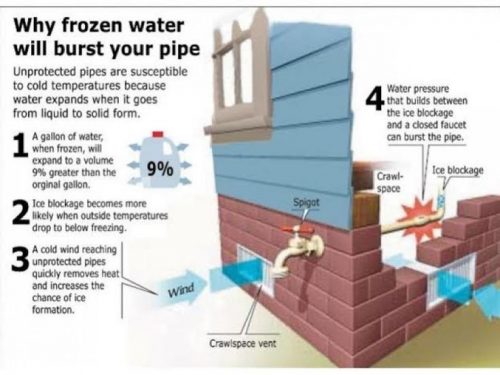Tips for avoiding a flood in your home when the weather warms up
With the deep freeze that has monopolized our region these past weeks, there is a chance that some pipes may have frozen. Here are a few tips to reduce any potential of bursting pipes when the warmer weather arrives and to save yourself a hefty plumbing bill.

Preventing pipes from freezing
Keeping your heat on is a no-brainer solution, but it can get expensive. However, if you’re leaving the house for a few days, consider keeping the house at 50F degrees or higher.
Letting your faucet drip if you’re worried about a pipe freezing is another way to relieve pressure, as pressure is what ultimately causes pipe bursts. Opening the cabinets underneath your bathroom sink is also a good way to keep them from getting too cold.
For pipes that are in extra-cold spots, using electrical heating tape to keep them warm is a good idea. You can also add extra insulation to pipes by fitting them with foam or rubber sleeves.
Spotting a frozen pipe
Your house is filled with water pipes, and while it’s not hard to figure out when you’re dealing with a frozen pipe, it can be tricky to figure out where the frozen section is. If you turn on a faucet and nothing comes out, you’re going to have to do a little detective work.
The first step should be to try all the other faucets in your house. If all the faucets in a room aren’t working, the freeze is likely in a split from the main pipe. If all the faucets on a floor aren’t working, the freeze is likely between where the first- and second-floor pipes separate. If all the faucets in your house aren’t working, then the freeze is probably near where the main pipe enters the house.
The frozen section of the pipe, if exposed, will likely have condensation over it. You’ll also be able to tell that it’s colder just from touching it.
Thawing a pipes
Before thawing the frozen section of your pipe, you should open the faucet to relieve the water pressure that has been building and allow the water to escape once it thaws. You should also begin the thawing process close to the faucet and work your way down to the blockage. If melted water and ice get caught behind the blockage, the chance that the pipe will burst increases.
One of the easiest ways to thaw a frozen pipe is with a hair dryer. You can also use hot towels or a heat lamp to warm the pipe up. Never use an open flame.
What to do if a pipe bursts
Don’t panic. The first thing you should do is shut off the main water line into your property. This will prevent your house from flooding. The main water valve is usually near your water meter. After you’ve done that, call your plumber.
Read more helpful tips in our Blog.
